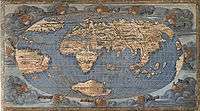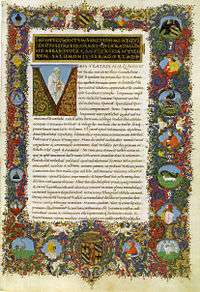Francesco Rosselli
Francesco Rosselli (1445 – before 1513) was an Italian miniature painter, and engraver of maps and old master prints. He was described as a cartographer, although his contribution did not include any primary research and was probably limited to engraving, decorating and selling manuscript maps created by others. He created many maps, including one of the first printed maps of the world to depict the Americas after Christopher Columbus' voyages. The attribution of prints to him is the subject of debate, as different engraving styles are used. This may be the result of different artists in his workshop, or of his and his shop's ability to use different styles.[1]


Life
Rosselli was born in Florence. He painted miniatures in manuscripts produced in 15th-century Florence, including copies of Ptolemy's Geographia and liturgical works for the city's cathedral. The so-called Tavola Strozzi, a view of the Bay of Naples depicting the return of the Aragonese fleet after the Battle of Ischia, has sometimes been attributed to his hand. Rosselli's pictorial engravings were heavily influenced by the paintings of his fellow Florentine Sandro Botticelli. Among his best-known works is a series of fifteen engravings of the Life of the Virgin and Christ.
In the 1480s, Rosselli left his wife and children with his half-brother Cosimo and left Florence for Hungary, because of debt according to his brother,[2] where he made maps for Matthias Corvinus, king of Hungary.[3] Upon returning to Florence, he started a shop to sell his engravings.[4] Rosselli may have been the engraver for some of the "new" maps in editions of Ptolemy's Geographia published in Florence in 1480–82.[5] He was also recorded in Venice in 1505 and 1508.[2] His shop also sold maps, and was the first known shop to market maps commercially. His two most famous maps date from 1506 and 1508. The 1506 Contarini-Rosselli map, his only signed and dated work, was the first printed map showing the New World.[2] Rosselli's 1508 world map was the first map drawn on an oval projection. This map may have been sold in his shop.[6] His 1508 map also depicted a Southern Continent where Antarctic continent is,[7] vaguely similar in general position to the Southern Continent on the Piri Reis map of 1513, the Lopo Homem map of c. 1519, the Juan Vespucci map of 1524, and other early maps. However, the Antarctic continent was not discovered until the early 19th century. There are many maps from the 15th to the 18th century showing "Terra Australis Incognita" ("unknown land in the south"), the continent that should have been there, according to the Greek philosophers from Pythagoras onwards. They had worked out that the Earth was spherical, and had even calculated its diameter within a good degree of precision (Eratosthenes, in the 3rd century BCE), and thought that, as there were lands in the northern hemisphere, there should be lands in the southern hemisphere too, lest the world be unbalanced.
References
- Konrad Oberhuber in Levinson:48–59 discusses the issue at length
- Levinson:47
- International Society for the History of Cartography: Imago Mvndi (page:24)
- Jay A. Levenson, Konrad Oberhuber, and Jacquelyn L. Sheehan, Early Italian Engravings from the National Gallery of Art (Washington DC, National Gallery of Art, 1973), pp. 47–62.
- Boorsch, Suzanne. "The Case for Francesco Rosselli as the Engraver of Berlinghieri’s Geographia,” Imago Mundi, vol. 56, no. 2, 2004, pp. 152–69.
- Roberto Almagià, “On the Cartographic Work of Francesco Rosselli,” Imago Mundi, vol. 8, 1951, pp. 27–34.
- image Archived 2006-12-19 at the Wayback Machine
| Wikimedia Commons has media related to Francesco Rosselli. |